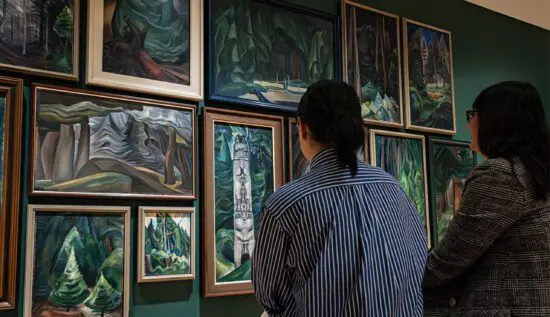Artist Profile: Motherload Collective
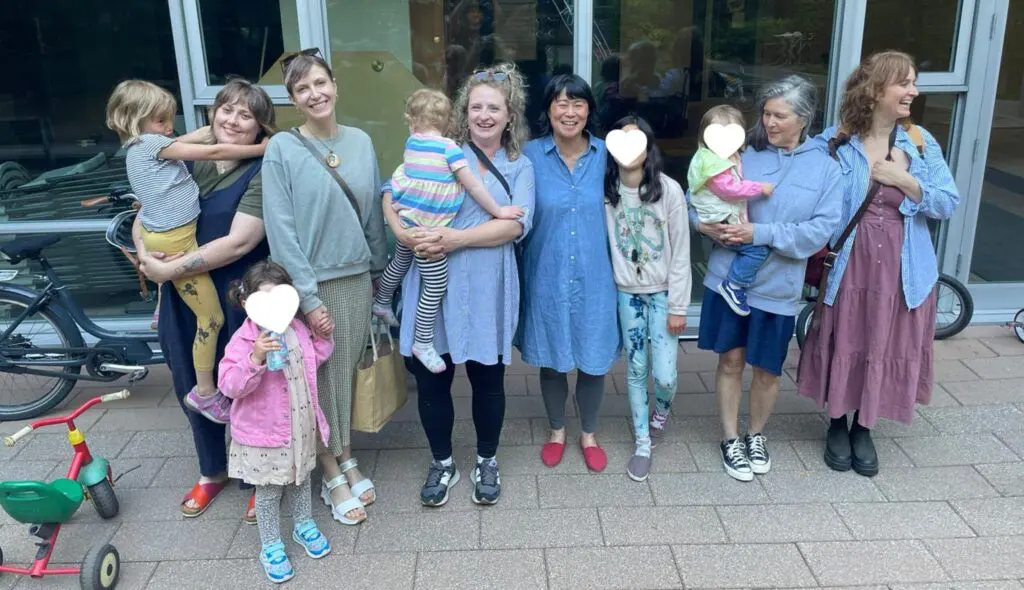
Motherload Collective, 2024, Courtesy of the Artists
Meet Motherload Collective!
In the summer of 2023, Vancouver–based artists and mothers Jessie McNeil and Anna Heywood-Jones founded the Motherload Collective—a meet-up group inspired by their involvement in community-engaged projects and family-inclusive residencies such as Mothra.
They were looking for ways to maintain their artistic practices while navigating the wild, heavy, sometimes isolating—and all-consuming—nature of parenting. What began as a series of monthly meetups with fellow artist-parents across the city has grown into a vibrant support network.
The group gathers to discuss the intersections of their creative work, personal lives and their place within (or sometimes on the margins of) the broader cultural community. They began coordinating monthly meetups with other artist-parents across the city to discuss issues and ideas arising from both their creative practices and personal lives, as well as from the larger cultural community they are part of—or, at times, have felt excluded from.
These gatherings alternate between Sunday morning family-centred potlucks—with toys, collaborative drawings and other shared activities—and weekday evening meetings that are more goal-oriented. At either meet-up, the collective prioritizes inclusivity, accessibility, resilience and radical care.
Now, the Motherload Collective includes the following Vancouver–based artists: Helene Aspinal, Kyla Bailey, Annie Briard, Amelia Butcher, Hannah Campbell, Diane Espiritu, Alison Fast, Haley Hunt-Brondwin, Anna Heywood-Jones, Sara Khan, Alice MacKenzie, Tehya MacKenzie, Jessie McNeil, Nicola Tibbetts, Leslie Urquhart, Leah Weinstein, Marlene Yuen, Clare Yow and Anna Zoria.
Jessie McNeil, Sara Khan and Nicola Tibbetts are represented by the Gallery’s Art Rental & Sales Program, and Kyla Bailey works in the Gallery’s Photography Department. Marlene Yuen’s work was featured as part of the Reading Room in the exhibition Copy Machine Manifestos: Artists Who Make Zines at the Gallery in 2024. Clare Yow has also taken part in public programs at the Gallery.
Their modes of making vary, and the children they care for range in age from a few months old to preteens. Some attend meetups regularly; others have more restrictive schedules. Not all have practices centred around motherhood, care or caregiving—but many do. What unites them is a shared commitment to sustaining their art while navigating the complexities of parenthood in community.
In celebration of Mother’s Day, we invited the group to share their reflections on being artist-mothers today.
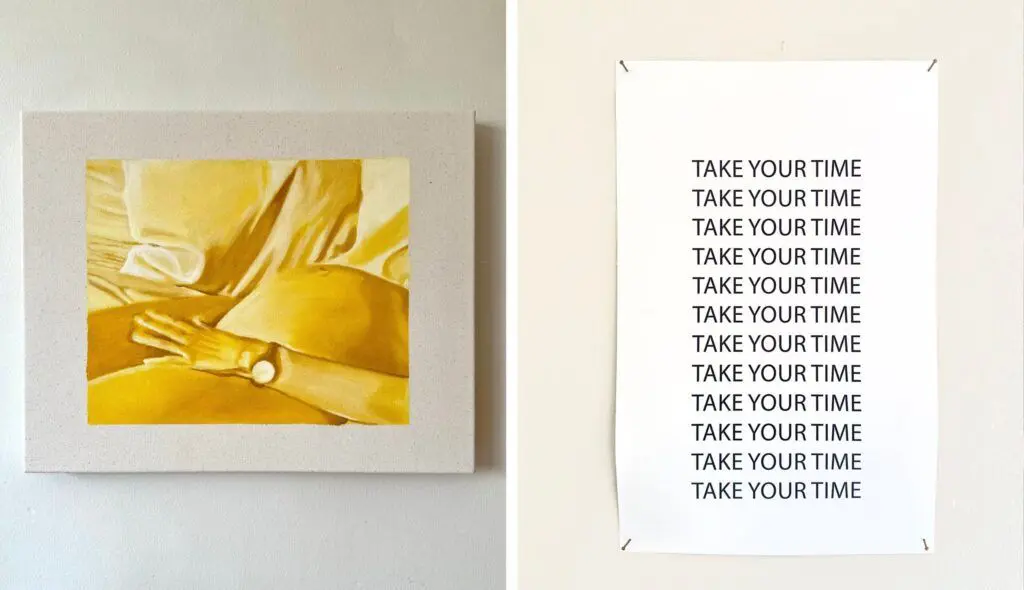
Anna Zoria, The Last Time I Had Time, 2025, oil on canvas and Take Your Time, 2025, print, Courtesy of the Artist
In what ways has parenting reshaped your artistic practices—either in form, content or rhythm?
Kyla Bailey: The creative urge vanished for me after becoming a mother until recently. Now that I’ve started creating again, I have to be very deliberate with my time. This goes against the nature of creativity as I’ve known it because you can’t control when the urge hits you. As a result, you have to get comfortable creating outside the bounds in which you are used to working. You have to get creative in your expression of creativity and make space for it whenever it shows up. I have started a few new projects that have to do more with simple, everyday routines. One photo project that I’m working on is involved with daily kitchen routines, making food and cleaning up again—the seemingly never-ending cycle.
My postpartum work has less to do with photography on a large scale and has been modified to fit into a more compact and micro space. I’ve had to become less of a perfectionist and more accepting of the fact that life is messy! I’ve found that there is beauty in the messiness of life.
Amelia Butcher: Pregnancy made me obsessed with Frankenstein, and I made a bunch of work about that. Parenthood has handed me a lot of new, big, artistically juicy questions.
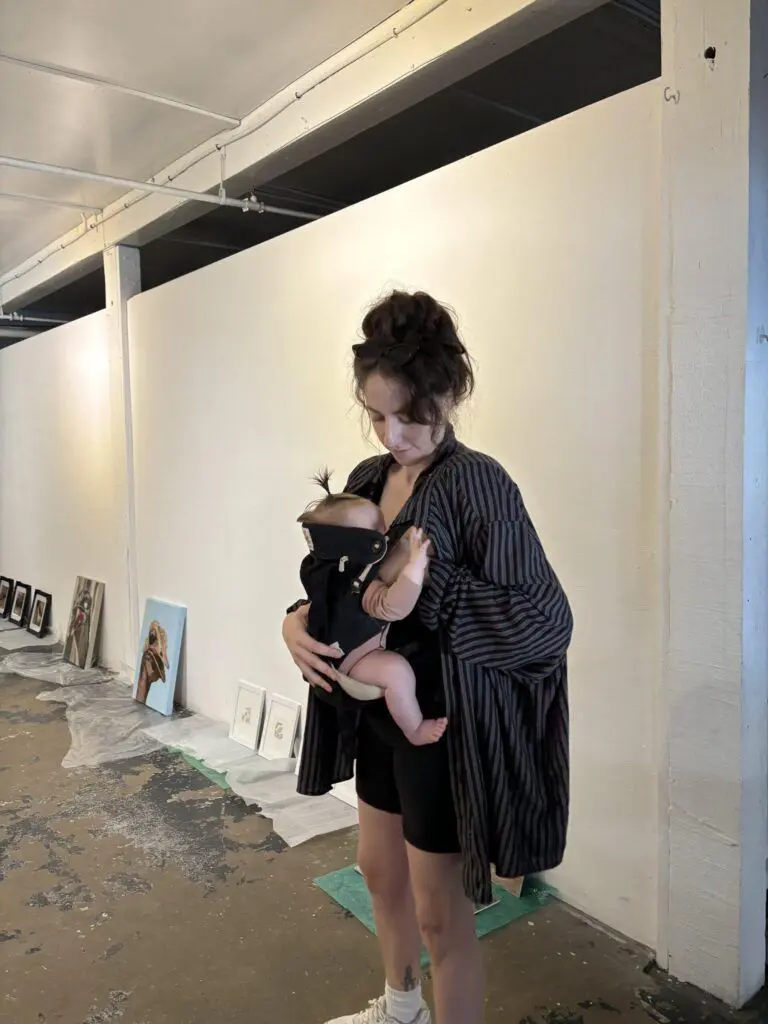
Alice Mackenzie installing artwork with her child, Courtesy of the Artist
Alice MacKenzie: Becoming a parent and being a mother to a young child has reshaped my art practice in nearly every way imaginable. My practice lives everywhere and nowhere these days. In my mind’s eye, it exists in a dark room as I rock my child, in bed on a dimmed iPhone screen, in play, in an unfamiliar studio, in long voice–note conversations with artist friends, in unexpected and unrefined mediums, and in the Motherloaders WhatsApp group chat. As a stay–at–home parent who works part time, my role as mother often eclipses possibilities in my professional practice; yet I find the act of parenting is inherently a creative practice, which I find incredibly fulfilling. I know my artistic practice will return to a more familiar shape as my child grows up and away from me, but for now, I will continue to meet it when I can and where I am.
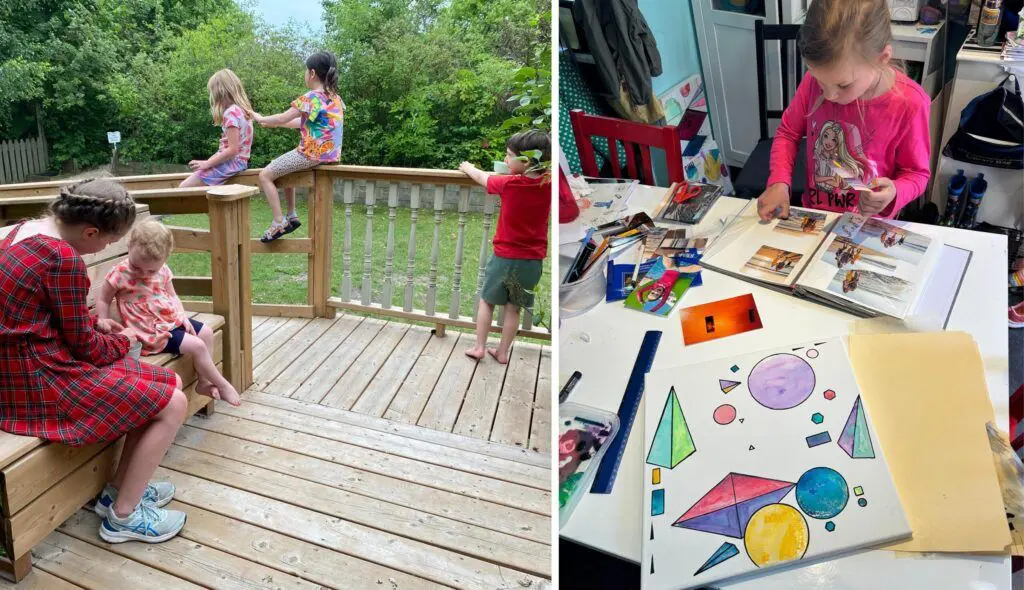
Children playing and making at during a Motherload Collective meet-up event, Courtesy of Motherload Collective
How do you see your children participating in, witnessing or influencing your creative work?
Kyla Bailey: My son has inspired me to think outside the box and to be more curious about the world. Motherhood has made me see the world in a new way. When I’m photographing something when he’s around, he wants to be involved in the photoshoot and help take photos.
Anna Zoria: Often when I’m making art with my daughter, I try to use my left hand in order to understand again what it’s like to be her. My left-hand line is so silly, wobbly and imperfect. I remember what it’s like to be a beginner again.
Yesterday, my daughter told me that the thumb on my yellow painting is too big and that maybe I could go somewhere where they can teach me how to paint thumbs. There’s humour in truth—she’s right, the thumb was too long.
Anna Heywood-Jones: My four-year-old son often participates in my practice, both out of necessity and through intentional collaboration. Recently, this has taken the form of cutting, sewing and weaving together. It is important to me to create space for him to witness and engage with the process of artmaking, though balancing the demands of caregiving with the need to maintain focus remains a continual negotiation.
Amelia Butcher: My son is in my studio a lot. I just installed a new exhibition, and I realized my kid was the only one who had seen every single piece before it went up. It’s interesting that this little witness is watching me as much as I watch him. When he responds to something I made, it just thrills me.
A few members of the group have participated in community-engaged and family-inclusive residencies, like Mothra. How have those experiences informed how you structure your gatherings and goals?
Jessie McNeil: Mothra is magic. You would think that a residency with often more than 10 different parents (outnumbered by kids) attending at the same time without childcare facilitation would be absolute madness. I dealt with a few tears, a dehydrated toddler and ran out of wet wipes for a minute, but mostly it was a place of care, compassion, support and intense creativity. Witnessing how other mothers make work while also caring for their children was so inspiring to me. We mothers also (somehow) all gathered at 4 PM for meetings to discuss a text or topic (older children looked after the younger ones nearby, or they sat on our laps…).
This utopic parenting and art-making environment, I’ve realized, is sadly impossible to recreate outside of this residency. We are all burning the candle at both ends, trying to stay afloat as parents and artists in Vancouver. But Motherload aims to offer a tiny slice of this nurturing Mothra atmosphere every month to its members when we meet in person. For those of us that can, we meet once a month, alternating between more focused evening gatherings in a studio or common space at a Motherloader’s co-op (like Mothra’s 4 PM meetings), and the wilder weekend morning ones with kids, snacks and collaborative projects. At either meet-up though, we make it clear that children are always welcome. There is value in letting them witness what their artist-mother’s do and to see how a community cares for mothers.
The tension between inclusion and exclusion in cultural spaces seems to be a recurring theme. What changes would you like to see in the broader art community to better support artist-parents?
Kyla Bailey: This is such an important and under-discussed topic! I think a big hurdle artist-parents face is finding a way to participate in the rigid schedules of exhibitions, workshops and residencies. Support for artist-parents could include flexible submission deadlines, or more residencies with some sort of childcare support. There is a lack of recognition in the artistic value of parenting so having grants or stipends specifically for artist-parents could help make the art world feel more inclusive.
Amelia Butcher: A small thing: When I bring my kid to a gallery I don’t like being tailed like we’re going to set the place on fire (this has never happened at VAG by the way!).
Jessie McNeil: Hettie Judah (“How Not to Exclude Artist Mothers (and other parents)”) writes about this beautifully. But I personally want to see more kids at art openings. Normalizing their presence in contemporary art spaces is important because it shows that caregivers and their efforts are at least acknowledged. However, to do this, art institutions need to recognize a few key problems that prevent us parents from attending shows or bringing our kids. Exhibition openings on a weekend is a good start; however, offering quieter events in the morning (openings with coffee and pastries?) before our toddlers go feral would be helpful. Although artist Carrie Allison had a show at Access Gallery a few years ago (a bead, a breath) which was child and caregiver-friendly during opening hours every day (think: artworks one can roll around with, goodie bags and snacks for little ones). Childcare facilitation at events that are not child-friendly with more quiet seating areas for nursing… Also some would argue that the standard height in which we hang art is outdated and ableist. The list goes on…
How do you navigate the balance between being caregivers and practicing artists, especially in a cultural climate that can undervalue both roles?
Jessie McNeil: There is no balance.
Amelia Butcher: There is no balance! I am trying to have the mindset that each role can feed each other instead of being adversaries. The problem is not within my caregiving or my practice itself, it’s external conditions.
Anna Zoria: I try to keep it realistic: I paint in 20 minute increments, in between doing my day job (I work from home) and life maintenance tasks. Keeping the materials out and the timer on is key for me.
Sometimes the best work is when I lean in to what I’m struggling with. For example, a recurring refrain in my head these days is: “there’s no time, there’s no time, there’s no time…”
So I think it will become the voiceover for a video piece, and the video footage can be of all these daily things I’m doing anyways. I can just film them, and that’s not necessarily much extra labor, but it’s art that’s right there, in the reality of my days.
When I really don’t have time, I make conceptual text pieces. And they really don’t take much time to make either. One piece just says “Take Your Time”; I made it in a word doc in 2 minutes. It’s something my daughter said to her pencil when she was drawing: Take your time, little pencil. Take your time.

Are there any collaborative projects or ideas brewing within Motherload that you’re especially excited about right now?
Kyla Bailey: We are all very excited about our upcoming inaugural show at Duplex at the end of May! I haven’t been part of the group for very long, but I’m super excited to see we can curate together as a collective around themes of time and mothering time, an experience we have all come to know through being mothers.
Jessie McNeil: Mothers, artist-mothers and self-employed primary caregivers in general are struggling. We have nothing but time, and yet we have absolutely no time. It’s a miracle that Motherload even exists considering how little time any of us have! Despite all this, and because of this, we have collaboratively put together a group show at Duplex Artist Society, which opens later this May. We hope for the opportunity to host a speaker series in the next few years and create publications. And there is an urgent need for affordable and child-friendly studio spaces with integrated childcare. I envision a space similar to Mother House Studios in London. Dream big, right!?
How do you define “radical care” within the context of your group, and how does it manifest in your meetings or in your artmaking?
Kyla Bailey: I would define radical care as the very deliberate act of making caregiving central to an artistic practice and community building in our group. Instead of having caregiving and artmaking in conflict, we have come to the realization that they are intrinsically linked in their creativity and resilience.
Motherload is always accepting of having children around at our meetings. Also, our bi-monthly meeting is a family friendly affair, where kids are central to the gathering. There’s never an expectation to perform professionalism—showing up messy, late or distracted is embraced rather than judged.
Anna Zoria: I think that we extend a lot of mothering, care and flexibility to each other. We plan our exhibition with everything we might need in mind: one person will take the kids to the playground, while a few others will do the install, for example. During our meetings we talk about things no one talks about, such as, how do artists make money? How much money do you make? How do you make it work? We don’t hold back, and we are honest with each other. We let each other cry. And we laugh a lot too.
For other artist-parents or caregivers who might be feeling isolated, what would you say to them? What has Motherload offered you that you didn’t have before?
Kyla Bailey: To other artist-parents who might be feeling isolated, I would say: you are not alone, and your experience—however chaotic, fragmented or unseen it may feel—is both valid and deeply valuable.
Motherload has offered me a space to feel like I belong. It’s a breath of fresh air knowing I’m in the company of others who get what it’s like to be an artist-parent. They understand what it’s like to create while your child naps in the next room or why you might have to miss an opening because of a bedtime routine. The group holds space for us not just as artists or parents but as whole people.
Amelia Butcher: A one-off event or connection is great but what has been so important about Motherload to me is that it’s ongoing, it’s a throughline, it’s a check-in. Sometimes it’s really intimate and deep conversations and sometimes it’s just like Marco? Polo! and both are actually equally valuable.
Leslie Urquhart: As a new member to Motherload, after a recent residency at Mothra, I find myself, for once, validated as a mother/artist. I no longer feel the urge to hide my “being a solo parent to two young kids” self anymore. I used to think people would think I was less professional or too wrapped up in parenting. How could I be a serious artist as well? I used to think I had to choose between being an artist and a mother, but I couldn’t. I need to create art to be happy, and my kids need me to be happy, so we are creative together.
At some point in my art/parenting career, I realized I couldn’t keep them separate. I can’t just produce art during the babysitter’s available hours. I needed to be able to make art at any time, with my kids around. They love watching me paint and helping me too, sometimes. They compliment me and tell me I’m the best artist in the world. What more validation do you need?
The great thing is you don’t have to choose. It’s not one or the other. You can be both a mother and an artist and a collective of these fine people and their children working together. What could be better? I’ve found my tribe, and I’m so proud to be part of the Motherload Collective. I’m so excited for the future.
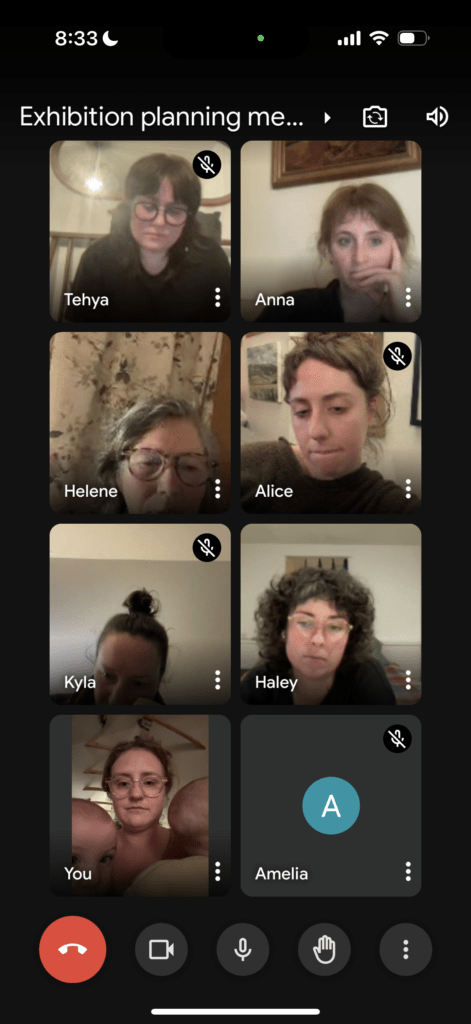
Motherload Collective meets on Zoom, 2025, Courtesy of the Artists
How do you hold space for the wide range of experiences within the group—from newborn care to parenting preteens, from regularly attending members to those who come when they can?
Kyla Bailey: Motherload really is about coming as you are and doing what you can. There are no expectations at all, and that’s what’s so beautiful about this group! It’s been amazing to see how everyone has come together to work as a team and help where they can but also feel comfortable enough to admit when they don’t have the bandwidth without feeling judged or pressured to show up 100% all the time. Maybe that’s why the group has been working so well so far!
What has surprised you the most—either about the work that’s come out of the collective, or the community it’s fostered?
Kyla Bailey: I think, so far, the most amazing thing that I’ve seen is the community that Jessie and Anna have built. It’s truly inspiring! It’s made me feel less critical of the times I haven’t had 100% to bring to the table. I have yet to see a lot of the work that we produce as I’m still pretty new to the group, but I’m so excited to see how our group exhibition Kairos: Mothering Time comes together. The images submitted so far of the work that will be in the show are gorgeous, so I’m very eager to see what the exhibit will be like!

